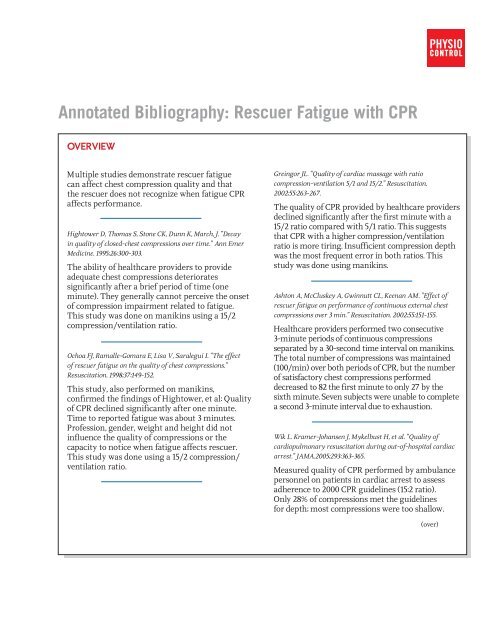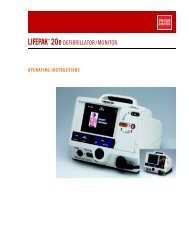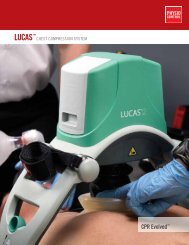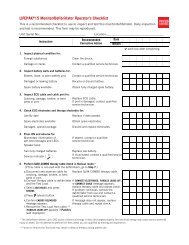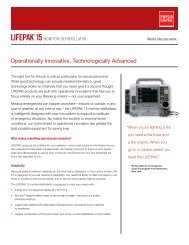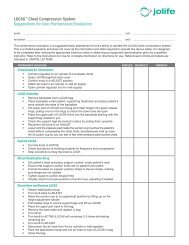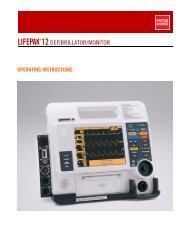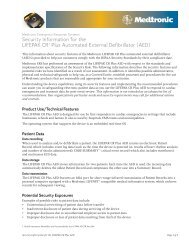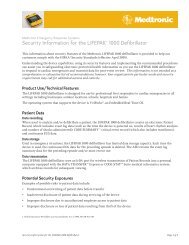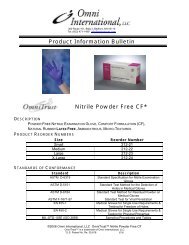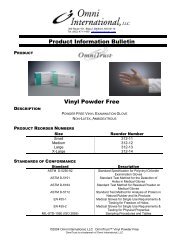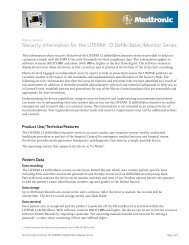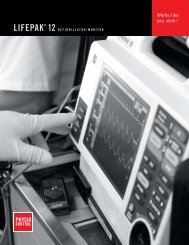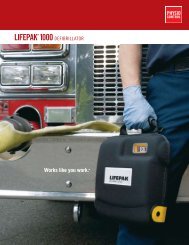Annotated Bibliography: Rescuer Fatigue with CPR - Physio Control
Annotated Bibliography: Rescuer Fatigue with CPR - Physio Control
Annotated Bibliography: Rescuer Fatigue with CPR - Physio Control
Create successful ePaper yourself
Turn your PDF publications into a flip-book with our unique Google optimized e-Paper software.
<strong>Annotated</strong> <strong>Bibliography</strong>: <strong>Rescuer</strong> <strong>Fatigue</strong> <strong>with</strong> <strong>CPR</strong>OverviewMultiple studies demonstrate rescuer fatiguecan affect chest compression quality and thatthe rescuer does not recognize when fatigue <strong>CPR</strong>affects performance.Hightower D, Thomas S, Stone CK, Dunn K, March, J. “Decayin quality of closed-chest compressions over time.” Ann EmerMedicine. 1995;26:300-303.The ability of healthcare providers to provideadequate chest compressions deterioratessignificantly after a brief period of time (oneminute). They generally cannot perceive the onsetof compression impairment related to fatigue.This study was done on manikins using a 15/2compression/ventilation ratio.Ochoa FJ, Ramalle-Gomara E, Lisa V, Saralegui I. “The effectof rescuer fatigue on the quality of chest compressions.”Resuscitation. 1998;37:149-152.This study, also performed on manikins,confirmed the findings of Hightower, et al: Qualityof <strong>CPR</strong> declined significantly after one minute.Time to reported fatigue was about 3 minutes.Profession, gender, weight and height did notinfluence the quality of compressions or thecapacity to notice when fatigue affects rescuer.This study was done using a 15/2 compression/ventilation ratio.Greingor JL. “Quality of cardiac massage <strong>with</strong> ratiocompression-ventilation 5/1 and 15/2.” Resuscitation.2002;55:263-267.The quality of <strong>CPR</strong> provided by healthcare providersdeclined significantly after the first minute <strong>with</strong> a15/2 ratio compared <strong>with</strong> 5/1 ratio. This suggeststhat <strong>CPR</strong> <strong>with</strong> a higher compression/ventilationratio is more tiring. Insufficient compression depthwas the most frequent error in both ratios. Thisstudy was done using manikins.Ashton A, McCluskey A, Gwinnutt CL, Keenan AM. “Effect ofrescuer fatigue on performance of continuous external chestcompressions over 3 min.” Resuscitation. 2002;55:151-155.Healthcare providers performed two consecutive3-minute periods of continuous compressionsseparated by a 30-second time interval on manikins.The total number of compressions was maintained(100/min) over both periods of <strong>CPR</strong>, but the numberof satisfactory chest compressions performeddecreased to 82 the first minute to only 27 by thesixth minute. Seven subjects were unable to completea second 3-minute interval due to exhaustion.Wik L. Kramer-Johansen J, Mykelbust H, et al. “Quality ofcardiopulmonary resuscitation during out-of-hospital cardiacarrest.” JAMA.2005;293:363-365.Measured quality of <strong>CPR</strong> performed by ambulancepersonnel on patients in cardiac arrest to assessadherence to 2000 <strong>CPR</strong> guidelines (15:2 ratio).Only 28% of compressions met the guidelinesfor depth; most compressions were too shallow.(over)
The compression part of the duty cycle was42% instead of the recommended 50%. Chestcompressions were not given 38% of the time.Abella BS, Alvarado JP, Mykelbust H, et al. “Quality ofcardiopulmonary resuscitation during in-hospital cardiacarrest.” JAMA. 2005;293:305-310.The quality of <strong>CPR</strong> was inconsistent and oftendid not meet <strong>CPR</strong> Guidelines (2000), even whenperformed by well-trained hospital staff onpatients in cardiac arrest. Chest compressionrates were less, compression depth was tooshallow, and ventilation rates were high.Abella BS, Sandbo N, Vassilatos P, et al. “Chest compressionrates during cardiopulmonary resuscitation are suboptimal:a prospective study during in-hospital cardiac arrest.”Circulation. 2005;111:428-434.Chest compression rates provided by trainedhealthcare providers in the hospital setting werebelow the AHA Guidelines (2000) recommendedrate and suboptimal compression ratescorrelated <strong>with</strong> poor return of spontaneouscirculation.<strong>Physio</strong>-<strong>Control</strong>11811 Willows Road NEP.O. Box 97006Redmond, WA 98073-9706 USATel: 425.867.4000Fax: 425.867.4121www.physio-control.com©2007 <strong>Physio</strong>-<strong>Control</strong>, Inc. a division of Medtronic. All rights reserved. MIN 3207713-000 / CAT 26500-002693


